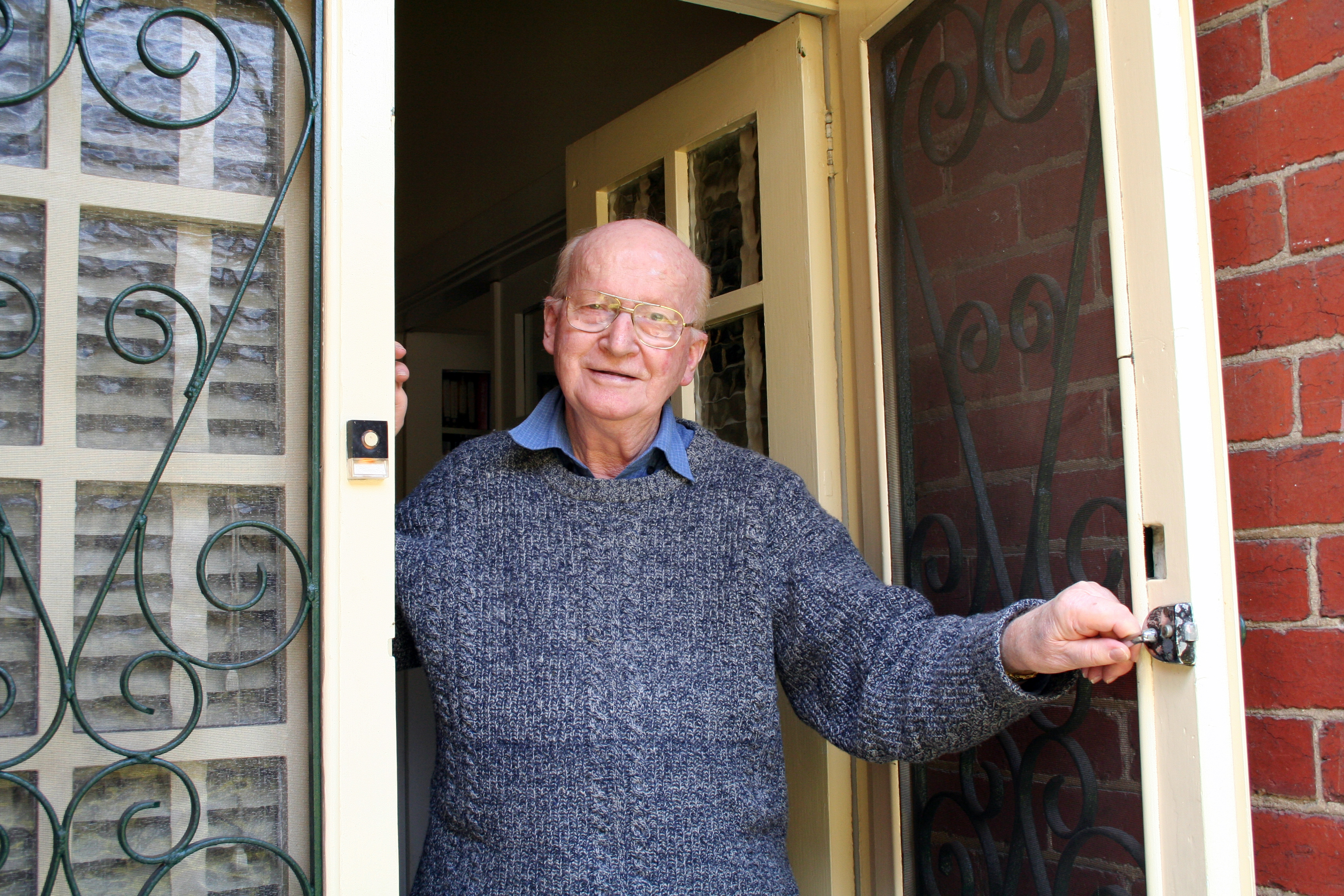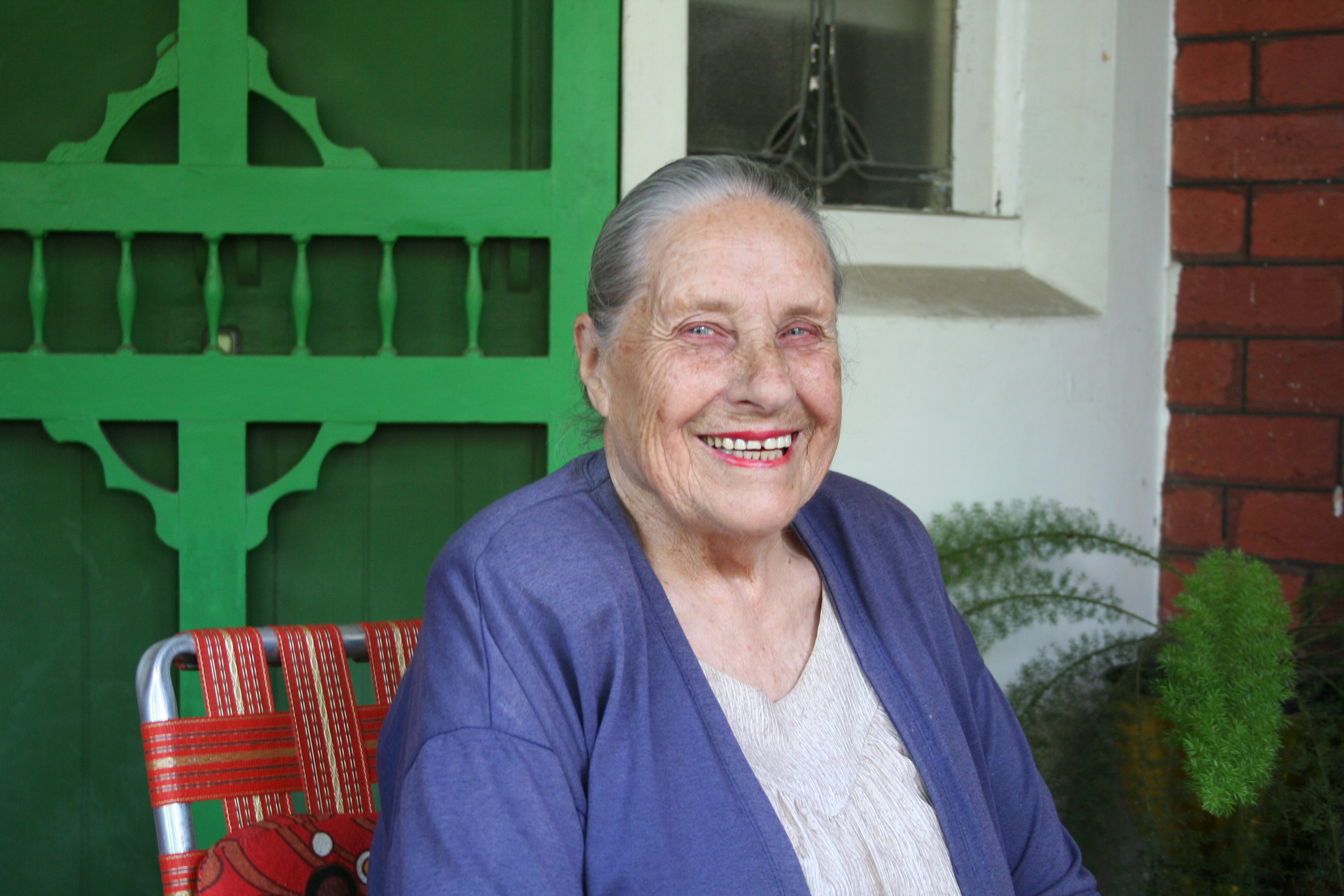|
FLOOD, FIRE AND FEVER A History of Elwood |
||
|
Acknowledgements
Recreation on the Hill and the Beach A Visit to Elwood Junction 1940s and 1950s Walking Tour of the Art Deco Apartments of Elwood Memories |
Elwood’s heritage resides also in the memories of its residents, many of whom have lived here for extraordinary periods of time. In 2003 the Margins, Memories and Markers Project recorded many residents’ stories about Elwood, particularly in the area of Elwood canal. Some of thee memories are scripted into heritage tiles on the banks of the canal from Glenhuntly Road to the sea. Others were contributed during heritage walks through Elwood village in August 2005 or collected in an Elwood Elders oral history project in 2004-2005.
Don Taggart (Julie Shiels) 1. Don Taggart: When I was a small boy there used to be a tram that ran from Elsternwick Station and Port Ormond, right past our house. The driver, a bit of a joker, eventually did. I was a skinny fellow so I got swept up into the air. Swinging back and forth, I begged the driver to let me down. He just sat on the step of the tram, roaring with laughter. My grandfather had a dairy in the 1890s, land from Wiltonia estate was sold for five pounds an acres. My grandfather wanted to buy a large area but was told by his wealthy cousin (from whom he wished to take a loan) that 'there's no future on the other side of the swamp'. The dairy moved to Wilton Grove 1914 - 1953. My father Ray, used to ride his horse to Elsternwick Primary School. He later joined the 4th Light Horse Brigade and won a DCM.
2. I had both my children while living in different parts of Elwood: Avoca Avenue and Bluff Avenue. The cobbled lawns were great for getting the babies off to sleep. I would walk them in the stroller on the bluestones of the lanes got them off to sleep in a flash. They were great!
3. The sea was always the place we went to for solace when life became too overwhelming when we had just arrived from Russia. I like to go to the park in Dickens Street at 7 pm and meet other Russian-speaking people.
4. The canal used to flood so often that kids would row you to the tram stop on Barkly Street for one shilling. It wasn’t far so I used to just take off my shoes and roll up my trousers. Pauline Thompson (Julie Shiels) 5. Pauline Thompson: in the 80s they wanted to build a nightclub on the Point that would stay open to the early hours of the morning. Elwood residents did what they always do well, they protested and it was stopped.
6. Isabella Dorfman: Every day we meet our friends and walk to the sea. This experience always brings back memories of the Ukraine and the transition to a new life made in Elwood.
7. Pauline Thompson: People used to dump unwanted animals into the canal. You’d always know when it was a dog because all the neighbourhood pooches would start howling. We’d go out and rescue them. During the 40s, hoons used to drive their cars up and down the canal at low tide. They’d enter here and speed up to Ruskin Street. If they got caught they’d get a kick in the pants and be told to go home. There used to be more than thirty boats anchored along this part of the canal. You can still see the rings in the wall. At 5 p.m., everybody used to go out fishing. My grandfather used to lower me down here (the canal) to catch worms. When it was time to get out, I’d hang onto the end of his fishing rod and he’d haul me out.
8. Ken Corbett: As a daily beachgoer in the forties and fifties maybe once or twice a summer you would see beach dolphins usually 200-300 yards off the beach.
9. Max Nicholson: In 1937, at the height of the polio epidemic, my Mum wouldn’t let me go anywhere near the canal. Like many Elwood parents, she thought that it was the source of the disease. That year, from June to September, the school was closed. We did our lessons by correspondence.
10. Julie Shiels: On the first anniversary of Aunty Bon’s death, we came to the place were she regularly walked. We sent little paper boats out to sea festooned with sparklers and filled with her favourite treats, oysters, chocolates and roses.
11. Helen Graham: Leaning on the rails of the canal bridge reminds me of my childhood on the Murray River.
12. Ann de Vries: My grandparents, Leslie and Annie Bott, lived on Marine Parade with their eight children from 1937-1975. During this time, they spent many enjoyable hours of the canal in their canoe. They used to launch it just across the road from their house, because that’s where the sea came to, before the land was reclaimed and turned into a park. We often laugh about the time my grandfather Leslie overloaded the family canoe and it sank in the shallow water. He directed the crew to right it, continued to smoke his cigar (for which he was renowned), and waded back to shore.
13. Katie Ragheb: One day when my son was riding home from school, he swerved and went hurtling into the canal. He hurt his arm, so we had to go and get a chair and lower it into the shallow water so he could scramble out.
14. Max Nicholson: During the Second World War, they built air raid trenches near the canal where the secondary college now stands. I can only remember one practice drill. I was a little fella so I had to struggle over the school fence with the boys. I didn’t want to be seen going through the gate with the girls.
15. In addition to these trenches (above) there were others on the vacant lot simply called ‘The Paddock’ adjacent to Windermere flats (49 Broadway) prior to the building of the police station and the health centre in the early forties and fifties. ‘The Paddock’ was not infrequently the site for a visiting circus during the forties.
16. During WW2 you couldn’t buy golf balls, so I used to take off my socks and get them out of the canal. I’d sell them for 4/- a piece. It wasn’t a thriving business, there was too much competition from other kids.
17. Michael Danby, Federal MP, in his maiden speech to Parliament: As a pupil at Elwood Central, I lost my first footy in the canal just up from where the 1920s gangster, Squizzy Taylor, had a hideout .
18. Michael Jennings: Most vivid of all my memories, were the Elwood Trams now gone. My grandmother having noticed that I liked riding them indulged me in many hours of tram rides from Terminus to Terminus. Staff were so familiar with us, they gave us our money back and would stop outside our house.
19. Ken Corbett: During the War, the Maison de Luxe was taken over as an administrative centre by the American forces, together with St Columba’s School. From where I lived at 47 Broadway, I can clearly recall the American dispatch riders known as Don R’s (motor bike couriers), thundering down the Broadway and then rocketing away in the direction of the city. A regular event during the very late forties / fifties, was a Sunday afternoon dance featuring Frank Johnson and the Fabulous Dixielanders which together with the Graeme Bell Jazz Band were the two foremost jazz bands nationally. Bodgies and Widgies had just come into being, and this event was a prime attraction for this new culture.
Maison De Luxe (Courtesy Don Taggart)
20. Michael Jennings: During the war, American troops were the attraction in beautiful uniforms with Guadalcanal on their epaulettes. The Australian troops took to wearing toilet paper on their shoulders inscribed Elwood Canal.
21. Rosalie Schaffer: When I was a girl, we lived at Clifton Hill and would take the bus to Elwood Beach. It was completely different then, covered with very thick tea-tree. We would arrive bursting with excitement and would disappear for hours exploring the tea-tree and the beach, a paradise for children.
22. Milk was delivered by horse drawn vehicles to Elwood homes as late as the 1960s when a milk horse had a fatal collision with a car in Vautier Street. I guess that was the abrupt end of the horse era.
23. Ken Corbett: Horse-drawn delivery of bread also continued during the forties and maybe fifties. The other horse-drawn product we kids looked forward to was the ‘Loys Man’ with the soft drinks.
24. Anon, Port Phillip Reflections: My family had a milk bar at 62 Ormond Road, Elwood. During the Second World War, our Mum would wheel me in the pram to the shop in the blackout. Clarrie the baker had a horse and cart and would deliver the bread in a huge can basket over his arm and also duck eggs. The garbage man had a cart and a huge draught horse, about 17-18 hands. He would walk along with a long-handled spade and toss the rubbish from the gutter over his shoulder into the cart without looking. The iceman would come and bring ice in a hessian bag on his shoulder. The Elwood Canal had yabbies in it and would flood regularly. Mum and I would wade in Foam Street up to our waists in the floodwater.
25. Mark Jason: Horry Peacock owned a shop at 82 Ormond Road called the Monarch Cycles and Sports Store. He assembled his own bikes with the Monarch brand on the frame. His shop was fantastic. When you entered there were so many bikes and parts piled up, there was hardly anywhere to stand. Then Horry would emerge from the back room. His jumper always had holes worn at the elbows and he was preceded or followed by his two large Irish setters. Liz Johnstone: Horry’s shop was an essential fixture of the Ormond Road shopping centre for many decades, and is celebrated by Horry Peacock Lane off Vautier Street. Horry was a former champion cyclist who often pumped up the bike tires of the local kids.
26. Joan Gibby: Waterway trails here are the link to our memory as a human connection to the place. I arrived here in 1985 with my mother Margaret and my father John. Children from Elwood Primary and High Schools planted traditional grasses one year; we made totem poles, to mark the edges of the old lagoon; and each year after we collected emu feathers, gums, nut shells for mobiles and rocks for making colours for a face.
27. Mimi Colligan: When I was seven in 1943, I used to walk to a private school in Selwyn Street with Germaine Greer who was aged four and guess who was the boss? The former school building is still there. Even at that age she was taller than me, imperious and stylish with her hair up. I caught up with her many years later when I approached her in the State Library in Melbourne to provide her with information about her grandfather that she was researching for ‘Daddy Dearest’. She was reluctant to talk saying the book was costing her ‘a thousand dollars a day’.
|
|

